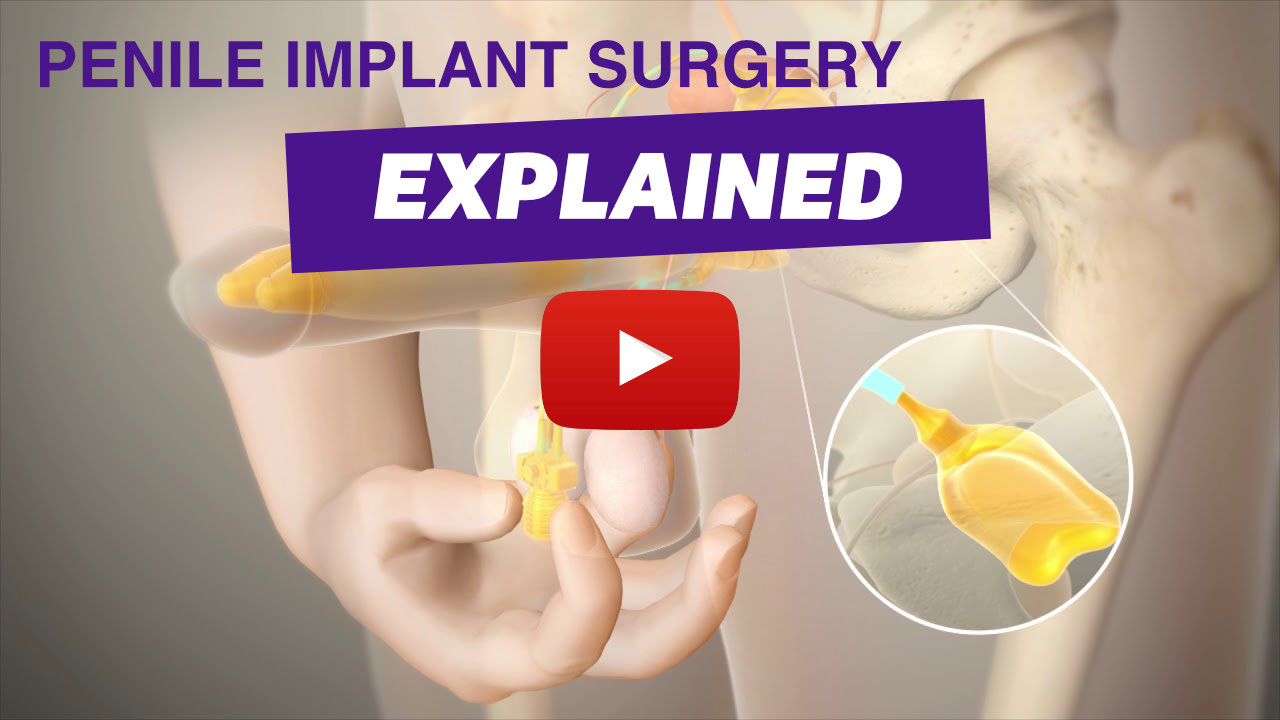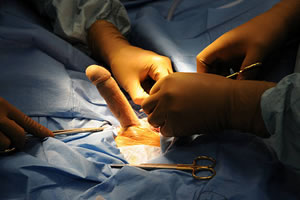Phallo.net » Resources » Videos
Penile Implant Surgery Explained
Penile implant surgery in people who have had gender-affirming Phalloplasty is especially challenging because of the lack of corporal bodies in a neophallus to accommodate the implant cylinders. In the video below, surgeons demonstrate a method of anchoring the AMS-700 penile prosthesis to the pubic bone to achieve stabilization adequate enough for sexual intercourse.
Warning: This video is graphic and age-restricted.

Surgery Technique Description
Incision (01:42)
A longitudinal incision is made along the previous phalloplasty
incision, again with care taken to avoid the blood supply, which
can be identified by palpation or handheld Doppler.
Dissection to the Pubic Symphysis (01:54)
Dissection is carried down to the pubic symphysis with
electrocautery and the location of the future corticotomy defect
is determined, ensuring it is in alignment with the neophallus and
planned cylinder position.
Corticotomy (02:11)
On the anterior aspect of the bone, the corticotomy is created in
the shape of an inverted cone, geometrically complementary to the
proximal rear tip extender. The depth and width of the corticotomy
site are checked periodically to ensure a precise fit.
Seating the Rear Tip (02:26)
You see the rear tip seats nicely in the defect. Note that as long
as a rear tip can accommodate an anchoring suture, any prosthesis
could be used for this technique.
Distal Dilation (02:37)
Distal dilation is performed, which again may be difficult given
that there are no true corporal bodies.
Measurement for Cylinder Length (02:47)
The phallic length is measured and the appropriately sized IPP is
selected.
Suture Placement (02:53)
Sutures are passed through the corticotomy defect, the rear tips,
and the proximal cylinder to allow the rear tip and the proximal
cylinder to be seated and secured in the bony defect. In our
patients, permanent anchoring sutures of either prolene or Ti-Cron
(Medtronic Minneapolis, MN, USA) were used.
Cylinders (03:31)
In this case, only 1 cylinder will be used based on the girth of
the neophallus, so the other is cut and the tubing is tied off.
Although capable of placing 2 cylinders, we have seen
aesthetically pleasing results with only a single cylinder in our
patients, with adequate sexual functioning of the device.
Completed Bony Fixation (03:30)
The anchoring sutures are next tied down. Here we see the secured
cylinder and rear tip within the corticotomy defect.
Passage of Keith Needle and Distal Placement of Cylinder (03:40)
The remainder of the procedure proceeds routinely. The Furlow
instrument is used to pass a Keith needle, facilitating distal
placement of the cylinder.
Two Cylinders (03:52)
An alternate approach, depicted here in a different patient, is
placing 2 cylinders. There may be additional difficulty using 2
cylinders due to lack of girth, fibrotic tissue, and the lack of
native corpora.
Additional Support (04:12)
An additional technique, which we have just recently begun to
incorporate, is depicted here, again in an alternate patient. A
hole for each cylinder is cut in a GOR-TEX strip (Gore &
Associates Inc, Flagstaff, AZ, USA); this material is secured at
the base of pubic symphysis.
The angle of force applied to the prosthesis may be important for durability. With an angle of force applied perpendicular to the corticotomy defect, the device is stable. Any motion that pulls the prosthesis away from the bone puts the patient at risk for device detachment. Female-to-male transgender patients are typically younger than the typical male patients receiving an implant for erectile dysfunction and may be at greater risk for device damage and malfunction. We hypothesize that this additional GOR-TEX may buttress the bone anchor of the prosthesis; however, this technique adaptation has not been attempted in enough patients to draw adequate conclusions on the effects on device longevity.
Reservoir Placement (05:04)
A counter incision is made in the right lower quadrant and carried
down into a subrectus pouch for placement of a reservoir.
Pump Placement (05:14)
The pump is placed to the right scrotal pouch previously occupied
by a tissue expander. Rarely, a counter incision in the scrotum
can be helpful for proper pump placement, in particular in cases
of revision, as depicted here in a separate patient.
 Final Steps (05:43)
Final Steps (05:43)
All tubing is connected and the incisions are closed.
This is the appearance of the neophallus with IPP at the
conclusion of the procedure.
SOURCE: Novel Technique for Proximal Bone Anchoring of
Penile Prosthesis After Radial Forearm Free Flap Neophallus.
Cohen AJ, Bhanvadia RR, Pariser JJ, Hatcher DM, Gottlieb LJ, Bales
GT. Urology. 2017 Jul;105:2-5.
Also see:
Last updated: 10/06/23